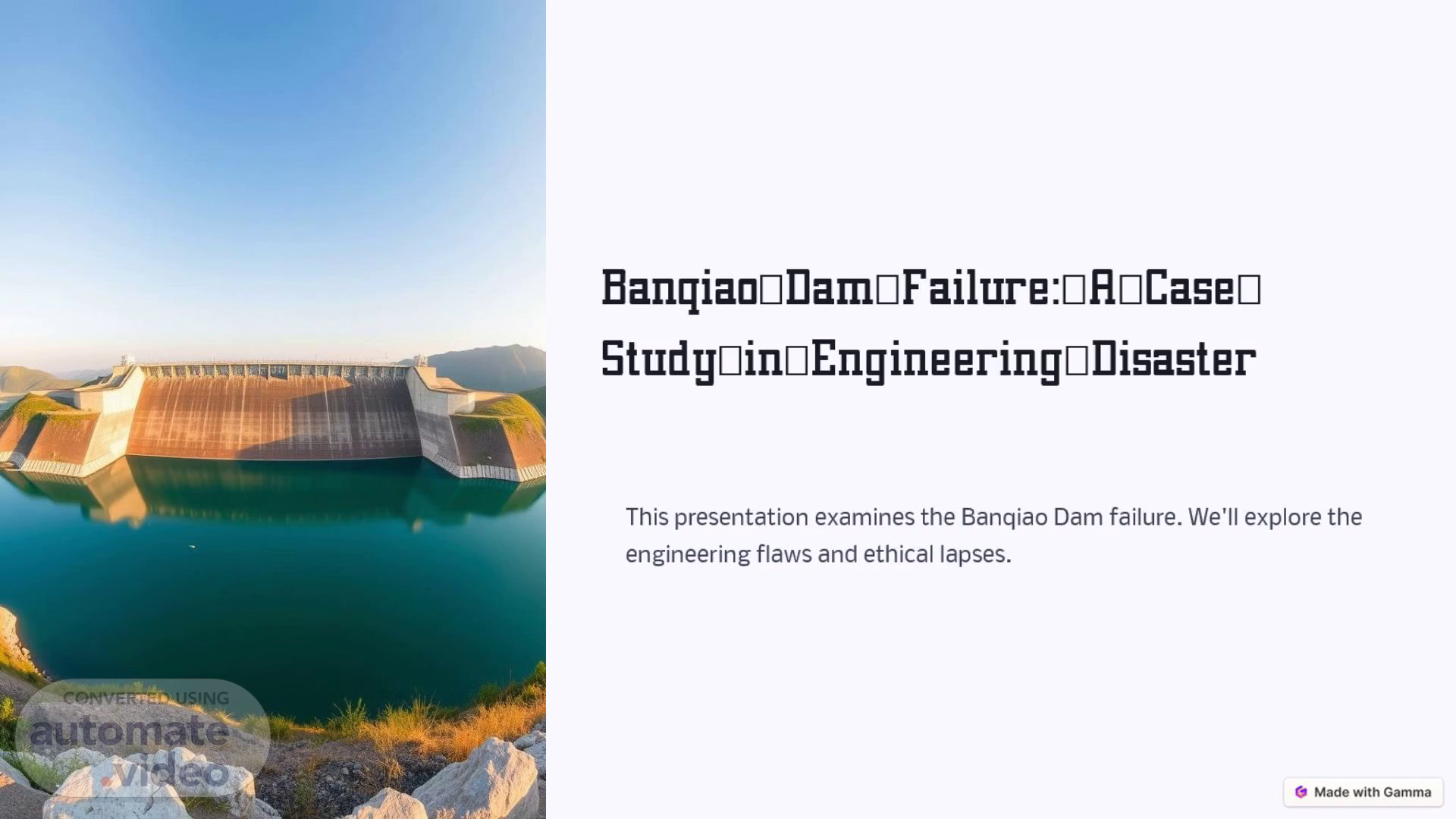Scene 1 (0s)
[Audio] Dams are designed to protect people from floods, generate electricity, and provide water for irrigation. However, when a dam fails, the consequences can be devastating. Today, we will discuss the Banqiao Dam failure—one of the deadliest engineering disasters in history. This presentation will analyze the engineering flaws, extreme weather conditions, and ethical failures that contributed to this catastrophe..
Scene 2 (27s)
[Audio] Before we begin, let me introduce our team members: Laiba Asif Muhammad Irtaza Abid Sohaib Abid Daniyal Baber Each of us has contributed to different aspects of this research to provide a comprehensive analysis of the Banqiao Dam disaster..
Scene 3 (43s)
[Audio] The Banqiao Dam was constructed in the 1950s as part of China's flood control system. Located in Henan Province, this dam was supposed to protect people from seasonal floods. However, in August 1975, an unexpected and powerful typhoon struck the region. The heavy rainfall exceeded the dam's capacity, leading to catastrophic failure. Over 200,000 people died as a result of drowning, starvation, and disease..
Scene 4 (1m 14s)
[Audio] Let's start by examining the engineering flaws that contributed to the failure of the Banqiao Dam: Inadequate Spillway Capacity – The spillway was too small to handle large-scale floods, making the dam vulnerable to overtopping. Poor Construction – The use of substandard materials and rushed construction led to long-term weaknesses in the dam's structure. Lack of Redundancy – There were no backup safety systems in place to handle emergency situations, increasing the risk of failure. These design and construction flaws made the Banqiao Dam highly susceptible to failure under extreme conditions."*.
Scene 5 (1m 54s)
[Audio] *"The Banqiao Dam failure was triggered by a series of catastrophic events: Heavy Rainfall – In August 1975, Typhoon Nina caused record-breaking rainfall that far exceeded the dam's capacity. Spillway Overtopping – Due to inadequate spillway capacity, excess water overflowed the dam's crest, weakening its structure. Dam Breach – Under extreme pressure, the dam collapsed, sending a massive wave of water downstream. Massive Flooding – The failure led to the destruction of entire villages, cities, and farmlands, causing immense human and economic losses. This disaster highlights the importance of designing infrastructure that can withstand extreme weather conditions."*.
Scene 6 (2m 45s)
[Audio] While the dam had structural flaws, extreme weather played a significant role in its failure: Typhoon Nina – This powerful typhoon brought an unprecedented amount of rainfall to the region, surpassing the dam's designed capacity. Hydrological Factors – The sudden increase in water volume put immense pressure on the dam's walls, leading to structural failure. Climate Impact – Unpredictable weather patterns and climate change have increased the frequency and intensity of extreme weather events, making infrastructure safety even more critical. This disaster underscores the need for engineers to consider extreme climate conditions when designing large-scale infrastructure projects."*.
Scene 7 (3m 29s)
[Audio] In addition to technical failures, ethical lapses played a crucial role in this disaster: Ignoring Warnings – Engineers and meteorologists warned about the structural weaknesses of the dam and the impending typhoon, but their concerns were dismissed. Poor Management – Authorities failed to take proactive measures, such as controlled water release, to prevent the disaster. Lack of Accountability – After the disaster, officials attempted to cover up the true scale of the tragedy, and no one was held responsible..
Scene 8 (4m 4s)
[Audio] The Banqiao Dam failure led to major reforms in dam safety and disaster preparedness. Key lessons include: Improved Design – Future dams must have redundancy in spillway capacity to handle unexpected flooding. Rigorous Inspection – Regular maintenance and safety assessments are essential to prevent structural failures. Emergency Protocols – Governments must implement effective warning systems and evacuation plans to protect communities in high-risk areas..
Scene 9 (4m 36s)
[Audio] In conclusion, the Banqiao Dam failure serves as a tragic reminder of the importance of ethical engineering and disaster preparedness. To prevent similar failures, we must: Prioritize Safety – Engineering projects should always put human lives first. Uphold Ethics – Governments and engineers must take responsibility for infrastructure safety and be transparent about risks. Learn from Failures – Every disaster provides valuable lessons that should be used to improve future engineering practices. By embracing these principles, we can ensure a safer future for all."* Thank you for your time and attention. We hope this presentation has provided valuable insights into the Banqiao Dam disaster..
